Water Plants in Tropical Permaculture
We have three water plants at Rancho Delicioso, all of which are considered invasive species and are illegal in places like Florida, because they can grow out of control, blocking waterways, covering ponds and lakes, etc. As with so many things in nature, they also have their benefits, so I wanted to discuss some of the pros and cons.
Species of Water Plants Here
Kangkong – Chinese Water Spinach
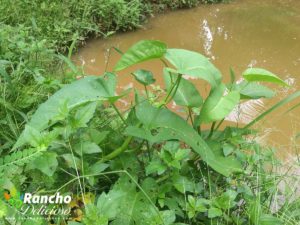 Ipomoea aquatica – Kangkong is a delicious water-weed that grow just about anywhere. It has a lot of names, but we’ve also heard it called water spinach and Chinese watercress.
Ipomoea aquatica – Kangkong is a delicious water-weed that grow just about anywhere. It has a lot of names, but we’ve also heard it called water spinach and Chinese watercress.
We originally planted it where we found a slow leak in one of our water tanks. So rather than fix the leak we decided to just use it as irrigation. Now we have it planted around the perimeter of some of our ponds.
It grows so fast, we can just harvest what we want and it comes back quickly. The leaves and shoots are good eaten both raw and cooked. It’s especially good cooked quickly at a high temperature in a wok with a bit of oil, garlic, ginger, and spicy red pepper. Perhaps add s splash of rice wine vinegar too. Add some soy sauce and sesame oil in the end if you like. It can also simply be added to any type of stir-fry dish like you might a spinach or other green.
There’s really no downside to this plant around here. Everyone should have some growing as an easy and healthy green food.
Wikipedia: https://en.wikipedia.org/wiki/Ipomoea_aquatica
Water Hyacinth
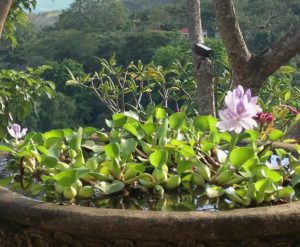 Eichhornia crassipes – This really pretty plant is also one of the fastest-growing in the world, and supposedly can double their population in only two weeks!
Eichhornia crassipes – This really pretty plant is also one of the fastest-growing in the world, and supposedly can double their population in only two weeks!
They are edible! You can eat the young leaves and shoots raw. Older ones need to be well cooked. The bulbs can be stir-fried and supposedly taste like pork rinds. The leaves taste like a mild collard greens. This plant has a lot of protein in addition to carbohydrates so it can be quite healthy: 18.7% protein, 17.1% fiber and 36.6% carbohydrates
The flowers are also used as a tonic for horses, by rubbing them on the skin. However, don’t let horses eat them. They’re toxic to horses, as well as to dogs and cats!
Wikipedia: https://en.wikipedia.org/wiki/Eichhornia_crassipes
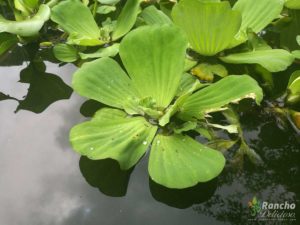 Water Lettuce
Water Lettuce
Pistia Stratiosis – Another highly invasive water week, this plant grows shockingly quickly and will seem to cover a pond while your back is turned!
It’s sort of edible, but not really recommended. If eaten raw, it will can burn your mouth like crazy. But when boiled it becomes edible and is eaten as a famine food in many parts of the world.
We’ve noticed our fish picking at its roots and at first thought they were eating them, but realized later that they were probably just munching on algae or something growing on them, because they certainly don’t hinder their growth.
Wikipedia: https://en.wikipedia.org/wiki/Pistia
Gotu Kola
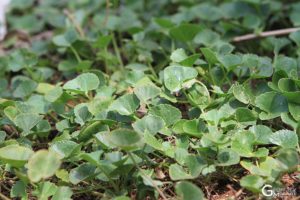 Centella asiatica – Gotu Kola is well known among people who study superfoods and medicinals herbs, because it’s said to be good for your brain, hence it’s known as “The Herb of Enlightenment”
Centella asiatica – Gotu Kola is well known among people who study superfoods and medicinals herbs, because it’s said to be good for your brain, hence it’s known as “The Herb of Enlightenment”
Chemicals in Gotu Kola reduce inflammation and blood pressure, and it’s also an antibacterial. It’s used to treat urinary tract infections, psychiatric problems, and many other types of infections and viruses too. A proven anti-inflammatory is really good for a lot of things in your body.
I recommend that people munch on a couple of leaves, raw, every day as you walk past it, as a little natural health boost. It’s just a little bit bitter but totally acceptable.
Web MD – List of Health Benefits: http://www.webmd.com/vitamins-supplements/ingredientmono-753-gotu%20kola.aspx
Wikipedia: https://en.wikipedia.org/wiki/Centella_asiatica
Do Water Plants Oxygenate the Water?
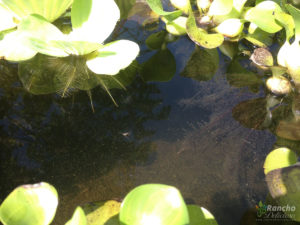 This is a good question, and like so many things, it depends on the situation. During the day, they put oxygen into the water, which is good for your fish. During the night, they take oxygen out, which is why you may find your Tilapia gulping air in the mornings. Overall, they put more oxygen in than they take out, so they are good for the pond.
This is a good question, and like so many things, it depends on the situation. During the day, they put oxygen into the water, which is good for your fish. During the night, they take oxygen out, which is why you may find your Tilapia gulping air in the mornings. Overall, they put more oxygen in than they take out, so they are good for the pond.
However, if you have too many of them, they can block the water’s surface from absorbing oxygen from the air. So we recommend keeping the surface not more than half-covered by these plants. The right amount of water plants blocks the sun during dry season, which helps keep the pond cooler too, which is going to be better for your fish and also reduces algae growth. At Rancho Delicioso, we harvest a couple of wheelbarrows of them, to mix into our compost, every week.
Useful as a Water Cleaner and Algae Prevention
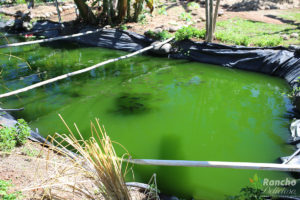 Water Hyacinth and Water Lettuce are great at absorbing nutrients from the water. They’re more efficient than algae, so are great to have in a tilapia pond to keep the algae levels under control.
Water Hyacinth and Water Lettuce are great at absorbing nutrients from the water. They’re more efficient than algae, so are great to have in a tilapia pond to keep the algae levels under control.
Their ability to clean makes them good for use in a greywater treatment pond too, and so have many uses in a farm or permaculture setup, especially if you have animals. Rain runoff that flows through an area housing pigs, chickens, etc, can be fed into a cleaning pond, and then the plants take out stuff you don’t want running into your streams.
They also absorb many types of toxins and heavy metals, which makes them dangerous to eat if they’re harvested in a river or pond that’s contaminated. They have also been used purposely to detoxify a water source by pulling out the heavy metals, harvested, and dealt with as a toxic waste elsewhere.
A Carbon Sink – Help Globals Warming
 Because they grow so fast, water plants are actively sucking massive quantities of carbon from the atmosphere.
Because they grow so fast, water plants are actively sucking massive quantities of carbon from the atmosphere.
If you harvest them regularly and turn them into soil, you’ll be really helping with global warming by sequestering the carbon into your topsoil.
Water Plants as Soil or Compost Additive
Water Hyacinth and Water Lettuce grow rapidly and are thus great to use as a mulching material, or for filler in our compost and soil making endeavors.
One possible challenge is that both plants produce a lot of Calcium Oxylate crystals. They are toxic to humans (hence the need to boil the plants before eating), but in the soil can be beneficial, because they are alkalizing. Many gardeners with acidic soil use powdered calcium to alkalize, but making soils with these water plants is a more natural substitute, and the calcium from these plants is more readily absorbable.
It also may be helpful to be aware of this alkalizing property. One option is to specifically use this plant to make soil that certain plants prefer. Here’s a list of plants that prefer more alkaline soil and that we’re already growing here:
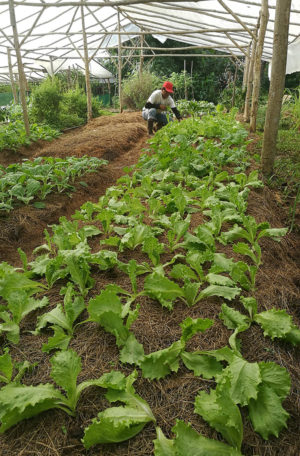 Arugula (6.5-7.5)
Arugula (6.5-7.5)Bean, pole (6.0-7.5)
Bean, lima (6.0-7.0)
Beet (6.0-7.5)
Broccoli (6.0-7.0)
Cabbage (6.0-7.5)
Cantaloupe (6.0-7.5)
Celery (6.0-7.0)
Chinese cabbage (6.0-7.5)
Chive (6.0-7.0)
Cilantro (6.0-6.7)
Collard (6.5-7.5)
Fennel (6.0-6.7)
Kale (6.0-7.5)
Kohlrabi (6.0-7.5)
Lettuce (6.0-7.0)
Mustard (6.0-7.5)
Okra (6.0-7.5)
Onion (6.0-7.0)
Oregano (6.0-7.0)
Pak choi (6.5-7.0)
Sage (6.0-6.7)
Spinach (6.0-7.5)
Squash, summer (6.0-7.0)
Swiss chard (6.0-7.5)
Watermelon (6.0-7.0)
**Source: Vegetable Crop Soil pH Tolerances
The amount of calcium in these plants is still very little compared to putting pure “cal” into the soil, but there are other benefits such as all the other nutrients that are in the plants too. So it stands to reason that using water plants to make our soils and compost should be really good, and we may benefit by trying some experiments with mulches of shredded water plants or other ideas.
Mosquito Breeders?
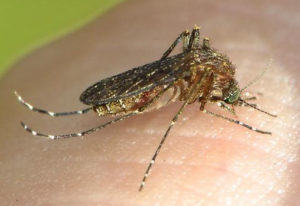 One of the downsides of having water plants is that both Water Hyacinth and Water Lettuce are the favorite places for Mansonia mosquitos to breed. They lay their eggs under their leaves near the water, and hatch in a week or so. Costa Rica has three species of Mansonia: Mansonia dyari, Mansonia leberi, and Mansonia titillans, which are considered to be “pest mosquitoes” because they bite humans and domestic animals like horses.
One of the downsides of having water plants is that both Water Hyacinth and Water Lettuce are the favorite places for Mansonia mosquitos to breed. They lay their eggs under their leaves near the water, and hatch in a week or so. Costa Rica has three species of Mansonia: Mansonia dyari, Mansonia leberi, and Mansonia titillans, which are considered to be “pest mosquitoes” because they bite humans and domestic animals like horses.
Mansonia mosquitos are large and black or brown, with “glittery legs”, and bite at night. They don’t carry Dengue or Zika viruses. We don’t seem to have a lot of these mosquitoes at Rancho Delicioso, perhaps because a pond also attracts a lot of dragonflies, and we have plenty of birds and bats around at night. If at some point in the future we find we have a problem with mansonia mosquitoes, we could try building several bat houses near the ponds to eat them, rather than going with the first instinct solution of removing the plants.
Mosquito Repellant?
While these water plants are considered a health hazzard because of the mansonia mosquitoes, it’s possible that water hyacinth could repel other types. Mary Perry, the owner of Rainsong in Cabuya, told me that she uses Water Hyacinth in the ponds of her landscaping projects, because they seem to repel mosquitoes from laying their eggs/larvae in the water.
I have searched the internet for any confirmation of this but haven’t been able to find any. However, I can report that at Anamaya, we have a large carved stone bowl filled with standing water and this plant, and no mosquitoes breed in it, so perhaps it works. I’m curious to know if anyone else has heard this or tried it.















